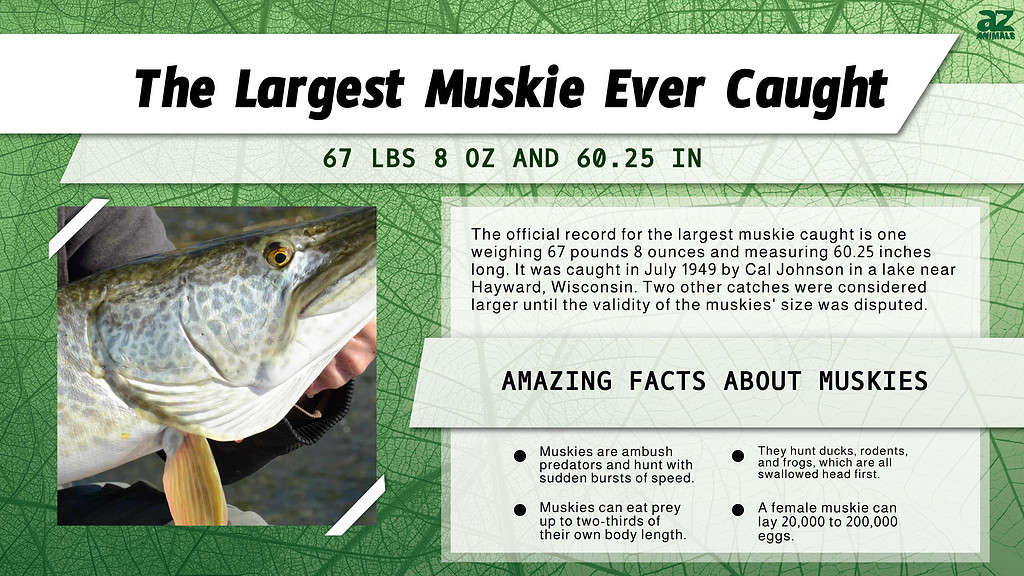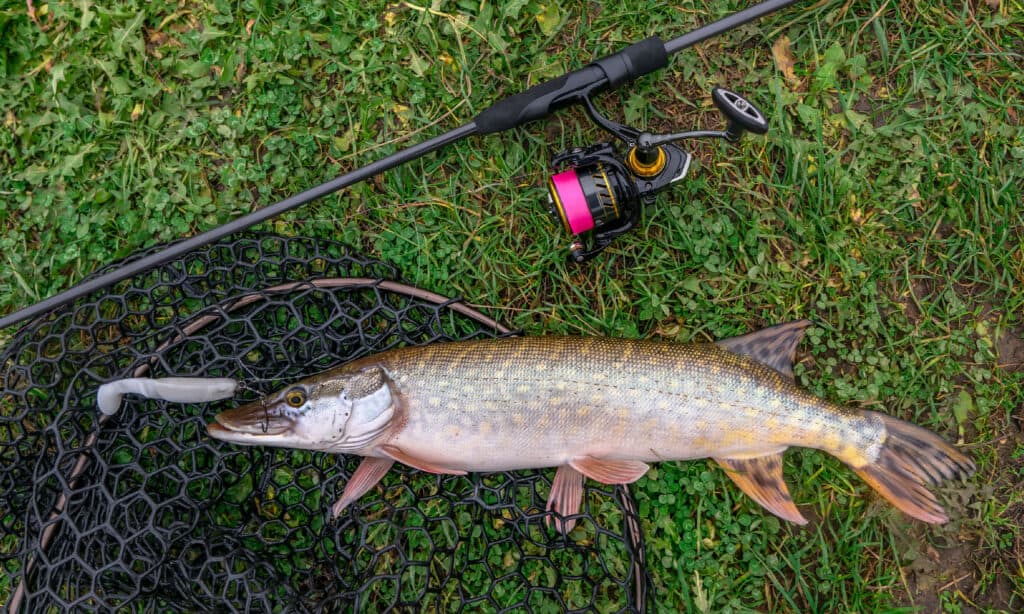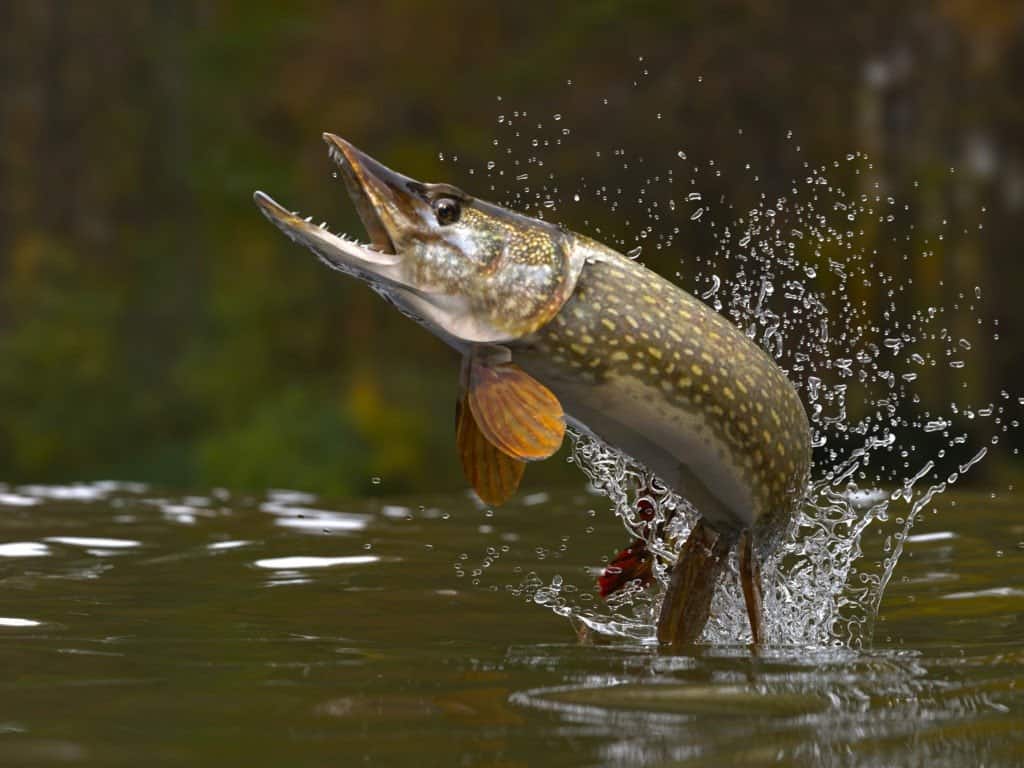Key Points:
- Muskie, or muskellunge, are a species of large and predatory freshwater fish native to North America.
- They thrive in clean, clear water bodies in the temperature range of 67 to 72°F.
- A typical muskie weighs between 15 to 36 pounds. The heaviest muskie ever caught was over 67 pounds, with some controversy surrounding the size of the top two muskie records.
Muskies are large freshwater fish that are native to North America. Known to be voracious predators with the ability to hunt and kill large birds and fish, muskies are apex predators within their home range. Therefore, with such an appetite, it’s not surprising that they can reach some incredible sizes. Their hefty size means that they are highly prized by anglers, with the world record being a coveted title. So, join us as we discover the largest muskie ever caught!

About Muskies
Muskellunge — commonly known as muskies — are the largest species in the Esocidae family group. Esocidae is the pike family and contains all pike, pickerel, and mudminnows. Muskies are on average 28 to 48 inches long and typically weigh 15 to 36 pounds. However, much larger specimens are not uncommon and are prized by sport fishermen. They are usually silver, brown, or green and sometimes have dark vertical stripes or spots on their flanks.
Muskies have a particularly similar appearance to the northern pike, which sometimes leads to confusion between the two. Despite this, one of the easiest ways to distinguish the two is their color. This is because muskies have dark markings over light bodies, which is the opposite of pike.
Muskies are widespread across North America and live in freshwater lakes and rivers. They prefer clear water and tend to live amongst the weed edges and rocks. These fish thrive in water that has different depth levels. This means that they can have two different ranges within their home territory: a deep one and a shallow one. During the summer, their shallow range tends to be warmer as the water has heated up.
Muskies are ambush predators and hunt with a devastating burst of speed. They are known for eating virtually anything that they come across. Like pikes, muskies are known for their ferocious mannerisms and are frequently described as being “the freshwater equivalent to the great white shark.” There are even reports of muskies attacking people and pets. Muskies can eat prey up to two-thirds of their own body length. They are apex predators that eat ducks, rodents, and frogs, which are all grabbed and swallowed head first.

Muskies are usually silver, brown, or green. They sometimes have dark vertical stripes or spots on their flanks.
©iStock.com/FedBul
From Something So Small
Incredibly, for a fish that ends up so large, muskies begin life as tiny hatchlings. Muskies spawn in the spring in water that is around 53.6°F. They also usually spawn in areas that are less than 3 feet deep and have rocky or sandy bottoms so that the eggs don’t sink into the mud. A female can lay anything from 20,000 to 200,000 eggs, depending on her size, after which she completely abandons them. Predators of eggs include insects and crayfish.
Upon hatching, the newly born muskies are tiny and are still vulnerable to predators. Once they have fully developed mouths, they begin to feed on zooplankton before moving on to small fish. However, muskies grow quickly, and by the time they reach their first winter, the juveniles are around 12 inches long. So, how big is the biggest muskie ever caught?
The Largest Muskie Ever Caught
For many years, it was believed that the largest muskie ever caught weighed 69 pounds 15 ounces. This immense fish was caught in 1957 in the St Lawrence River by Arthur Lawson. However, a great amount of controversy was raised over whether the fish was actually the size he claimed it to be. Although Lawson officially held the world record for 20 years, photographs of the fish have been examined in more recent times. These examinations have led to suggestions that the size of the fish could well have been exaggerated. This has eventually led to Lawson and his fish being stripped of the title as the world record holder of the biggest muskie ever caught.
However, it’s not as simple as reinstating the previous title holder, as that catch itself is also the subject of similar controversy! This muskie weighed 69 pounds 11 ounces, meaning that if correct, Lawson’s record catch is 4 ounces heavier. However, this fish was caught in Chippewa Flowage, Wisconsin in October 1949 by Louis Spray. Spray himself was a colorful character who had a reputation as a bootlegger. This — along with the lack of photographs of him holding the fish — led to questions being raised about the validity of his catch.
Therefore, officially the largest muskie ever caught goes back even further, although this time only to July 1949. This time, the muskie weighed 67 pounds 8 ounces and measured 60.25 inches long. It was caught by Cal Johnson in a lake near Hayward, Wisconsin. Johnson was a well-known angler and a writer for various fishing magazines, and several people witnessed the catch and weighing of the fish. This catch at least isn’t the subject of any controversy, although no one will ever know whether it is actually the biggest muskie ever caught.

There has been debate about the size of the largest muskie ever caught.
©M Huston/Shutterstock.com
Where Is Hayward, Wisconsin Located on a Map?
Hayward lies to the northwest of North Woods Beach, Round Little Lake, and Chief Lake. It also lies to the east of Stanberry and south of the Tall Pines Resort. The region is home to Hayward Lake, with nearby lakes including Indian School Lake directly to the north of the area and Smith Lake, which lies slightly further to its north.
How Do Muskies Compare to Other Fish?
We’ve already mentioned that muskies are the largest fish in the pike family, but just how much bigger are they, and how do they compare against other freshwater fish? Well, most pikes are 16 to 22 inches long. However, the longest is 59 inches, and the heaviest is around 63 pounds. This means that muskies are significantly heavier than them, although the longest pikes are a similar length to the longest muskies. The longest pickerels are around 54 inches long and the heaviest 46 pounds, again meaning that muskies are easily the larger fish.
However, when it comes to the largest freshwater fish, muskies are much, much smaller. The largest of the freshwater fish are beluga sturgeons, which can reach a maximum length of 23 feet 7 inches. They can weigh up to an immense 3,463 pounds! The largest freshwater fish in North America is also a sturgeon, although this time the white sturgeon. White sturgeons can reach 20 feet long and weigh up to 1,800 pounds, again dwarfing muskies.

Pikes share similar lengths with muskies.
©bekirevren/Shutterstock.com
The photo featured at the top of this post is © M Huston/Shutterstock.com
Thank you for reading! Have some feedback for us? Contact the AZ Animals editorial team.






